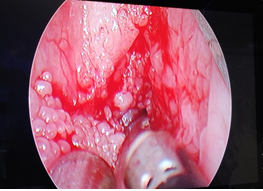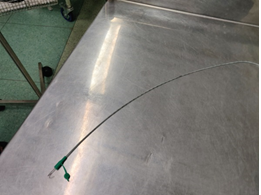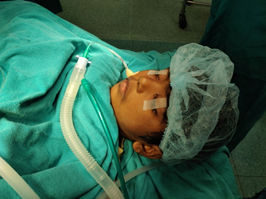Improvisation Can Accomplish the Need of Hour
Article Information
Anie Gupta*, Richa Saroa, Uma Rathi, Sanjeev Palta
Government Medical College and Hospital, India
*Corresponding Author: Anie Gupta, Government Medical College and Hospital, India
Received: 29 November 2019; Accepted: 16 December 2019; Published: 27 December 2019
Citation: Anie Gupta, Richa Saroa, Uma Rathi, Sanjeev Palta. Improvisation Can Accomplish the Need of Hour. Anesthesia and Critical Care 1 (2019): 48-50.
Share at FacebookAbstract
Paediatric airway management is often challenging. In maxillofacial surgeries or child with difficult airway, method of safe extubation is the use of an airway exchange catheter (AEC). But in resource limited set up there may be difficulty in achieving a small sized AEC. Here was a case of 3 years old female child, known case of juvenile onset of respiratory recurrent papillomatis with anticipated difficult extubation, where an AEC was required which could be inserted in a PVC endotracheal tube of size 3.0 mm ID, so it was improvised with the available material. It might facilitate reintubation when necessary and could assist in administering oxygen to the patient.
Keywords
Paediatric airway exchange catheter; Difficult extubation
Paediatric airway exchange catheter articles, Difficult extubation articles
Paediatric airway exchange catheter articles Paediatric airway exchange catheter Research articles Paediatric airway exchange catheter review articles Paediatric airway exchange catheter PubMed articles Paediatric airway exchange catheter PubMed Central articles Paediatric airway exchange catheter 2023 articles Paediatric airway exchange catheter 2024 articles Paediatric airway exchange catheter Scopus articles Paediatric airway exchange catheter impact factor journals Paediatric airway exchange catheter Scopus journals Paediatric airway exchange catheter PubMed journals Paediatric airway exchange catheter medical journals Paediatric airway exchange catheter free journals Paediatric airway exchange catheter best journals Paediatric airway exchange catheter top journals Paediatric airway exchange catheter free medical journals Paediatric airway exchange catheter famous journals Paediatric airway exchange catheter Google Scholar indexed journals Difficult extubation articles Difficult extubation Research articles Difficult extubation review articles Difficult extubation PubMed articles Difficult extubation PubMed Central articles Difficult extubation 2023 articles Difficult extubation 2024 articles Difficult extubation Scopus articles Difficult extubation impact factor journals Difficult extubation Scopus journals Difficult extubation PubMed journals Difficult extubation medical journals Difficult extubation free journals Difficult extubation best journals Difficult extubation top journals Difficult extubation free medical journals Difficult extubation famous journals Difficult extubation Google Scholar indexed journals Airway exchange catheter articles Airway exchange catheter Research articles Airway exchange catheter review articles Airway exchange catheter PubMed articles Airway exchange catheter PubMed Central articles Airway exchange catheter 2023 articles Airway exchange catheter 2024 articles Airway exchange catheter Scopus articles Airway exchange catheter impact factor journals Airway exchange catheter Scopus journals Airway exchange catheter PubMed journals Airway exchange catheter medical journals Airway exchange catheter free journals Airway exchange catheter best journals Airway exchange catheter top journals Airway exchange catheter free medical journals Airway exchange catheter famous journals Airway exchange catheter Google Scholar indexed journals Anesthesia articles Anesthesia Research articles Anesthesia review articles Anesthesia PubMed articles Anesthesia PubMed Central articles Anesthesia 2023 articles Anesthesia 2024 articles Anesthesia Scopus articles Anesthesia impact factor journals Anesthesia Scopus journals Anesthesia PubMed journals Anesthesia medical journals Anesthesia free journals Anesthesia best journals Anesthesia top journals Anesthesia free medical journals Anesthesia famous journals Anesthesia Google Scholar indexed journals
Article Details
1. Paediatric Anaesthesia
Airway management plays a pivotal role in paediatric anaesthesia. Children are not merely small adults. There are important airway related differences which require different approaches and equipment in airway management of paediatric group. Forewarned is forearmed. In maxillofacial surgeries, child with difficult airway may develop severe respiratory distress early after extubation and require emergent reintubation. One potential useful method of safe trial of extubation in such scenario or in paediatric intensive care unit is use of an airway exchange catheter (AEC). AEC is a small hollow catheter, which can remain in place in airway allowing for administration of oxygen via continuous flow and also subsequent reintubation over AEC [1, 2]. But in resource limited set up there may be difficulty in achieving a small sized AEC which can be accommodated in paediatric small sized endotracheal tubes. Smallest size AEC available in the hospital was of 4.5 mm sized.
In this communication we draw attention towards experience with a 3 year old female child, known case of juvenile onset of respiratory recurrent papillomatis. Informed written consent to publication of this case report was taken from patient’s father. She was admitted with complaints of difficulty in breathing and swallowing since 3 days and planned for coblation excision of the lesions. She had underwent MLS under general anaesthesia when it was found that papillomatous lesions involved full length of bilateral true vocal cords, bilateral ventricles, bilateral medial aspect of the false vocal cords and in supraglottic region upto 5 mm (Figure 1A) Patient was found to have reduced glottic chunk but was intubated uneventfully with ET tube ID 3 mm but it was found that intraoperatively lesions got extended to subglottic region and trachea also. Therefore, it was predicted that there might be difficult extubation, where an AEC was required which could be inserted in a PVC endotracheal tube of size 3.0 mm ID, so it was prepared with the available material.
A 6FG infant feeding tube of outer diameter 2 mm was taken with a guide wire of central line inserted in it to make it quiet rigid (Figure 1B) Successful tracheal intubation can be a achieved with this as stylet in case of reintubation. The distal end of infant feeding tube was cut in a bevelled shape at length of 20 cm and a connector of 2.5 mm sized endotracheal tube attached to the proximal end after removing guide wire to administer oxygen to the patient (Figure 1C).

Figure 1A: False vocal cords and in supraglottic region upto 5 mm.

Figure 1B: 6FG infant feeding tube of outer diameter 2 mm.

Figure 1C: Endotracheal tube attached to the proximal end after removing guide wire.
Thus PAEC provides a method for continuous administration of oxygen and can be used as a stylet for tracheal reintubation. Correct placement can be tricky due to the short length of trachea and inadvertent extubation or bronchial intubation remain an omnipresent risk. The other concern remains ventilation through this tube which necessitate insertion of endotracheal tube over fashioned infant feeding tube.
In conclusion the use of such an improvised PAEC may facilitate reintubation when necessary, and can be a life-saving method. It allows a safer trial of tracheal extubation and can assist oxygenation the patient.
References
- Wise-Faberowski L, Nargozian C. Utility of airway exchange catheters in pediatric patients with a known difficult airway. Pediatr Crit Care Med 6 (2005): 454-456.
- Mort TC. Continuous airway access for the difficult extubation: the efficacy of the airway exchange catheter. Anesth Analg 105 (2007): 1357-1362.
